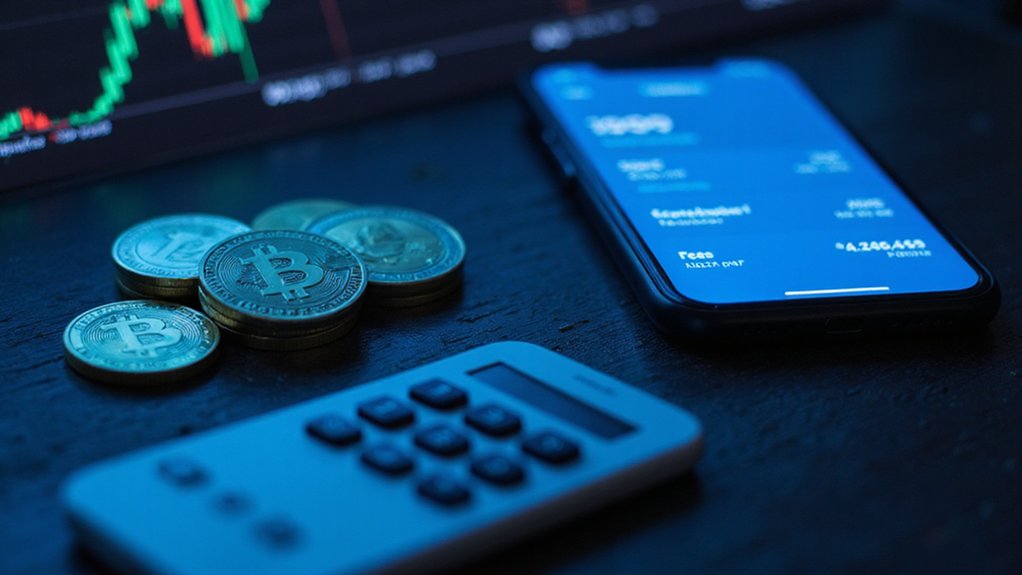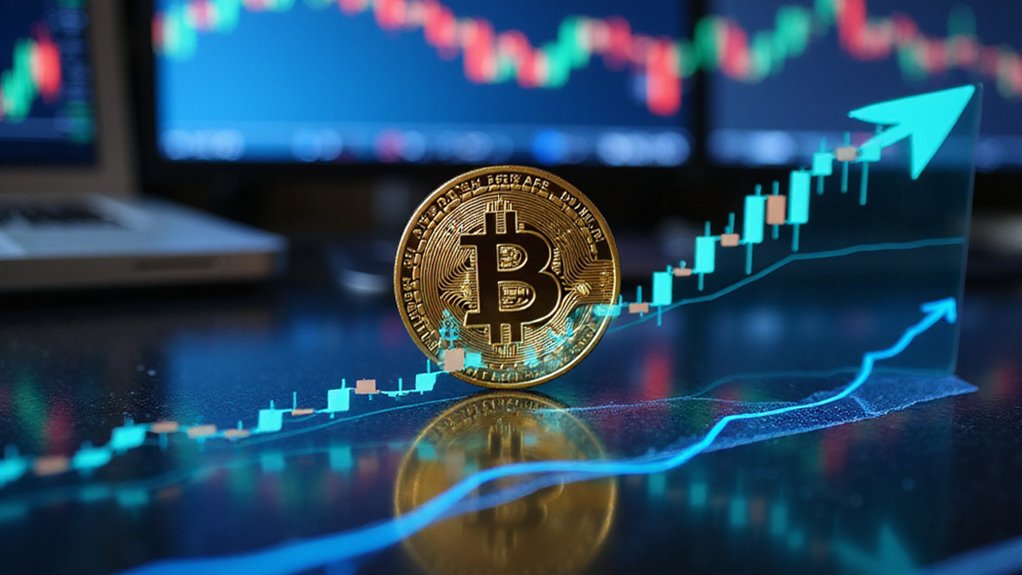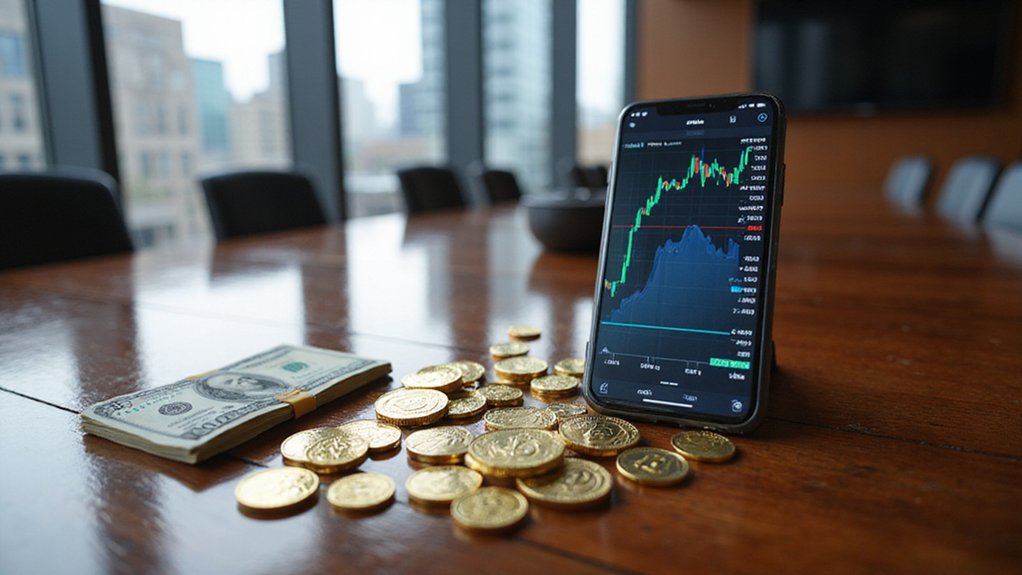Coinbase employs a multi-tiered fee structure where standard trades incur a hefty 4% while Advanced Trade users enjoy rates as low as 0.4%. Deposit costs vary by method (bank transfers free, cards not so much), and withdrawals fluctuate with network congestion. The platform skims 35% from staking rewards—quite the haircut—while spread markups constitute hidden costs. Strategic users can minimize expenses through limit orders, Coinbase One membership, or well-timed withdrawals. The devil, naturally, lurks in the fine print.

A labyrinthine fee structure awaits the uninitiated Coinbase user, spanning from the potentially eye-watering 4% on standard buy/sell transactions to the more palatable 0.4% for advanced traders placing limit orders.
Navigating Coinbase’s fee labyrinth requires discernment—standard users face steep 4% costs while savvy traders find relative sanctuary at 0.4%.
This gradient of expense reflects Coinbase’s bifurcated approach: casual investors subsidize the platform while volume traders enjoy comparative respite.
The platform’s taker fees—those charged when removing liquidity from the market—exceed their maker counterparts, though they remain mercifully lower than standard transaction costs.
The deposit and withdrawal landscape presents its own financial topography.
While cryptocurrency deposits incur no charges (a minor miracle in the fee-laden cryptosphere), fiat deposits vary dramatically by method—bank transfers typically cost nothing while card deposits extract their pound of flesh.
Withdrawal fees similarly fluctuate based on the chosen blockchain network’s congestion, with ethereum transactions occasionally reaching eyebrow-raising levels during periods of network saturation.
Staking activities come with their own fiscal considerations.
Coinbase’s 35% commission on rewards for assets like ADA and ATOM might seem steep (indeed, it is), yet the platform counters with the benefit of instant unstaking without penalties—a feature not universally available.
Their Coinbase One subscription attempts to offset this commission rate with enhanced staking rewards alongside its $30 monthly fee.
The true cost of Coinbase usage often lurks in less conspicuous corners: spread markups on standard trades create an implicit fee beyond stated rates; currency conversion adds further expense; and network fees fluctuate with blockchain traffic.
When accessing your cryptocurrency, it’s essential to find your wallet address through either the web platform’s “Send/Receive” button or the mobile app’s “Transfer” option.
When compared to competitors like Binance (starting at a mere 0.1% for spot trading), standard Coinbase fees appear decidedly astronomical, though Advanced Trade rates achieve reasonable parity at higher volume tiers.
Those seeking to minimize their financial outlay would be well-advised to utilize Advanced Trade’s maker-taker structure, consider Coinbase One if trading frequency justifies the subscription cost, and assiduously avoid high-fee deposit methods.
Timing withdrawals during network lulls can further mitigate blockchain fees—small optimizations that accumulate to meaningful savings over time.
Frequently Asked Questions
How Do Coinbase Fees Compare to Other Cryptocurrency Exchanges?
Coinbase generally commands higher fees than competitors, particularly through its standard interface (1.2% taker vs. Crypto.com’s 0.5%).
While Advanced Trade offers competitive rates for high-volume traders, Coinbase’s fee structure remains criticized for its complexity and hidden spreads.
Crypto.com provides clearer schedules and greater discounts through token staking.
Importantly, Coinbase excels with lower BTC withdrawal fees and free USDC transfers on L2 networks—small consolations in an otherwise premium-priced ecosystem.
Can Coinbase Fees Be Tax Deductible?
Coinbase fees can indeed be tax deductible, though the IRS doesn’t make this straightforward (naturally).
For casual investors, fees are typically incorporated into the asset’s cost basis—effectively reducing taxable gains rather than functioning as standalone deductions.
However, those conducting cryptocurrency activities as a trade or business may deduct these fees as ordinary and necessary expenses.
The classification of one’s crypto activities—hobby versus profession—proves rather consequential in determining the appropriate tax treatment.
Does Coinbase Offer Fee Discounts for High-Volume Traders?
Yes, Coinbase does offer fee discounts for high-volume traders through a tiered structure based on 30-day trading volume.
As traders climb the volume ladder, their maker-taker fees progressively decrease—a standard industry practice that rewards those who bring liquidity to the exchange.
Professional and institutional traders can access more substantial discounts, particularly through VIP programs which, rather predictably, remain somewhat opaque regarding exact qualification thresholds until one approaches their hallowed territory.
How Often Does Coinbase Update Their Fee Structure?
Coinbase updates its fee structure on a periodic basis without adhering to a fixed schedule.
These revisions typically follow multi-year patterns (2019, 2022, 2025) and are calibrated to prevailing market conditions, global trading volumes, and competitive positioning.
While announcements come via public blog posts, the exchange rarely provides 30-day advance notice—changes are often communicated mere days before implementation.
Structural modifications commonly include tier consolidations, threshold adjustments, and maker/taker incentive recalibrations to optimize liquidity depth.
Are There Ways to Minimize or Avoid Coinbase Fees?
To minimize Coinbase fees, savvy traders employ several tactical approaches: utilizing Coinbase Advanced rather than the standard interface; placing limit orders instead of market orders (the maker-taker differential is non-trivial); opting for ACH deposits over credit cards; batching transactions when possible; and—for the volume-inclined—leveraging tier-based discounts.
The Coinbase One subscription presents a compelling proposition for active traders, eliminating fees on up to $10,000 monthly volume—a rather elegant solution for the fee-conscious investor.









